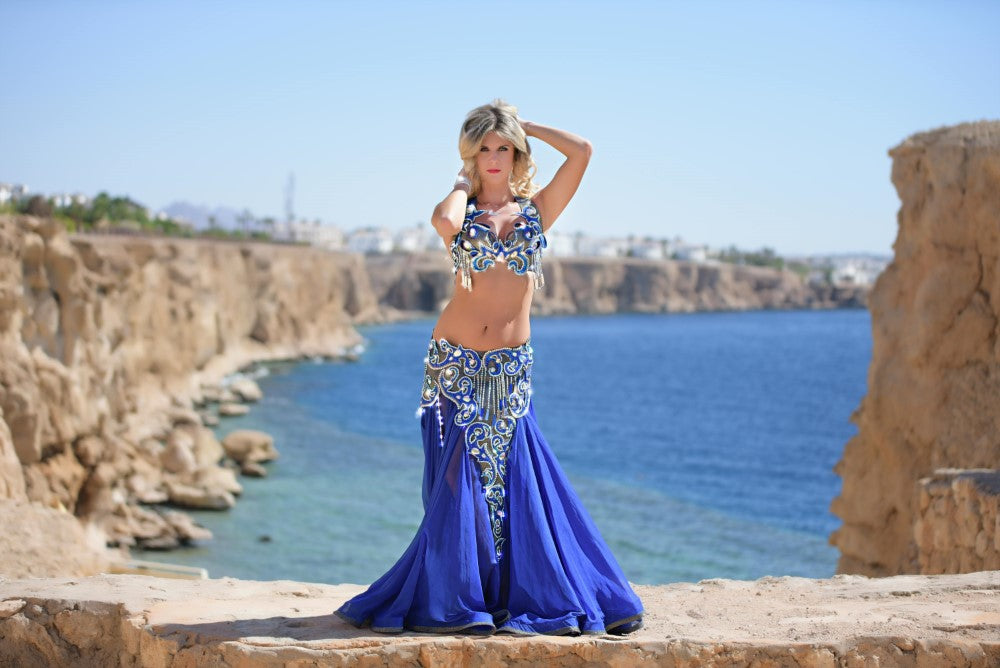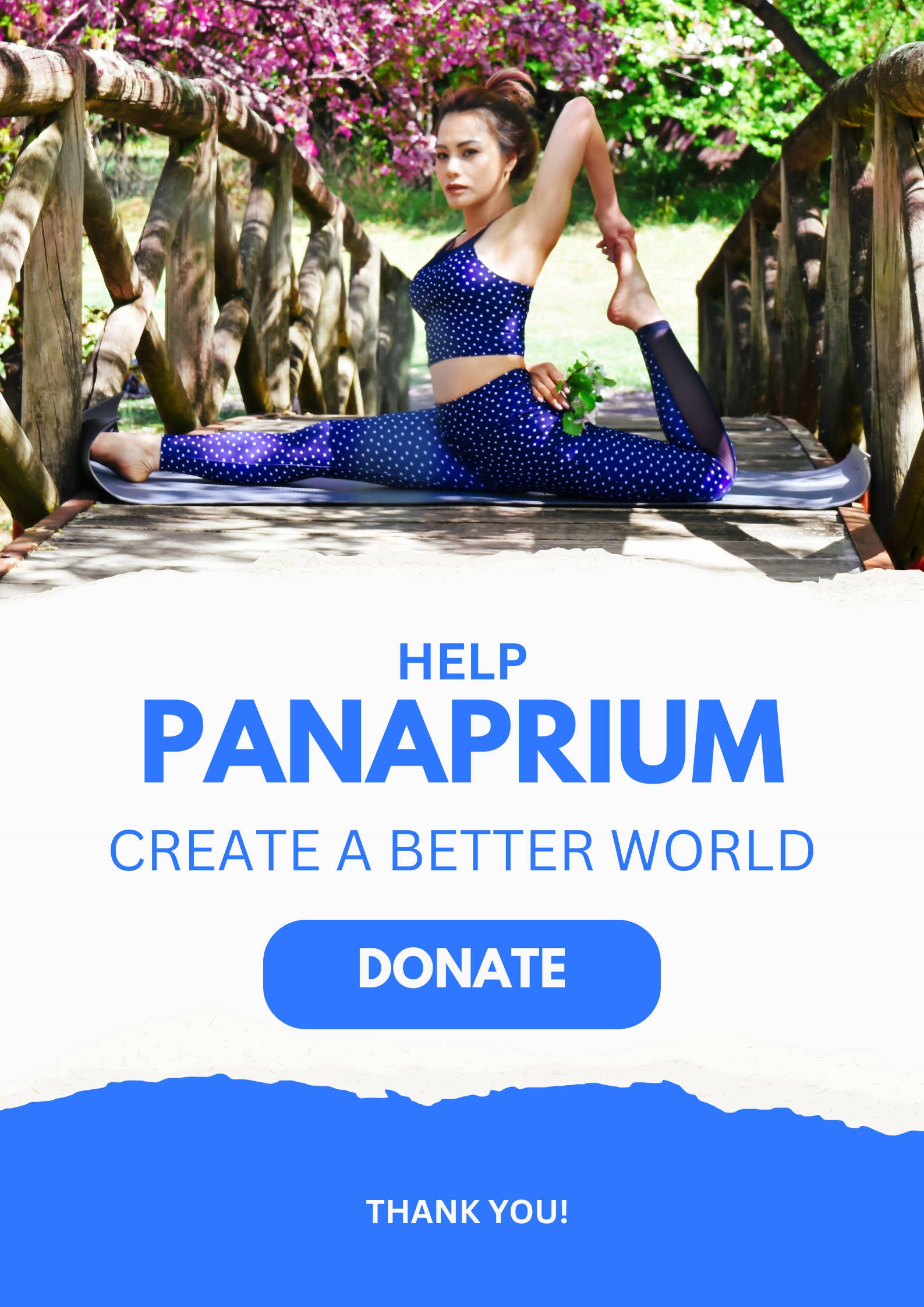
Bauchtanz ist ein einzigartiger Tanzstil, dessen Tänzerinnen vor allem für ihre geschickten Hüft- und Oberkörperbewegungen und aufwendigen, detailreichen Kostüme bekannt sind. Dieser Tanzstil hat sich auf der ganzen Welt verbreitet und den modernen Tanz und die moderne Kultur beeinflusst.
Bauchtanz hat seinen eigenen, einzigartigen Kleidungsstil. Diese Tanzkleidung betont den Bauch der Tänzerin, um die komplexen Bewegungen ihres Oberkörpers und ihrer Hüften zu einem anregenden Beat besser hervorzuheben. Bauchtanzstücke betonen die Bewegung auch durch Geräusche, die durch Münzen und Strasssteine erzeugt werden, die überall an ihrer Kleidung angebracht sind.
Beginnen wir mit den Anfängen des Bauchtanzes und sehen wir uns an, wie sich der Bauchtanz zu verschiedenen Stilen entwickelte und weltweit an Popularität gewann. Sie werden nicht nur einige schöne, glänzende Kleidungsstücke sehen, sondern auch mehr über diese traditionelle Tanzform erfahren.
Panaprium ist unabhängig und wird vom Leser unterstützt. Wenn Sie über unseren Link etwas kaufen, erhalten wir möglicherweise eine Provision. Wenn Sie können, unterstützen Sie uns bitte monatlich. Die Einrichtung dauert weniger als eine Minute und Sie werden jeden Monat einen großen Beitrag leisten. Danke schön!
Geschichte

Laut World Belly Dance lässt sich der Bauchtanz bis ins 15. Jahrhundert zurückverfolgen, nämlich bis nach Ägypten und in die Türkei. Dieser Tanzstil war im Nahen Osten sehr beliebt, und gewöhnliche Menschen kamen zusammen, um gemeinsam zu tanzen, wie World Belly Dance es beschreibt:
„In Ägypten war Tanz schon immer Teil von Hochzeitsfeiern. Er wurde von Partygästen als Gesellschaftstanz und von Künstlern, die dafür bezahlt wurden, zu besonderen Anlässen zu tanzen, als professioneller Tanz aufgeführt.“
Im 18. und 19. Jahrhundert tanzten Darsteller auf der Straße für Reisende aus verschiedenen Ländern. Viele dieser Reisenden waren Männer aus konservativen Ländern, die die Tänze fremd und skandalös fanden.
Dieser Tanzstil wurde 1893 während der Weltausstellung in Chicago auf die Hauptbühne gebracht, als eine Tänzerin namens „Little Egypt“ vor Publikum auftrat. Ihr Tanz löste eine Welle der Kontroverse aus, wie World Belly Dance feststellte : „Einige liebten ihre Bewegungen, andere waren davon schockiert (denken Sie daran, welche Wirkung ein Tanz gehabt haben muss, bei dem sich der Oberkörper frei bewegen konnte, in einer Gesellschaft, in der Frauen Korsetts trugen).“
In den 1970er und 1980er Jahren erlebte der Bauchtanz in den Vereinigten Staaten erneut eine Renaissance, als er laut World Belly Dance während der feministischen Bewegung als Mittel zur Feier von Macht und Weiblichkeit genutzt wurde.
Auch heute noch lernen viele Menschen diese beliebte Tanzform. Ihr Einfluss ist auch im modernen Tanz und in der modernen Kleidung sowie in der Popmusik und bei Kabarettaufführungen zu finden.
Bauchtanzstile

Als sich der Bauchtanz auf der ganzen Welt verbreitete, entstanden verschiedene Stile. Laut Belly Dance ähneln sich die Stile Ägyptens und der Türkei in ihren Bewegungen und traditionellen Kostümen.
Allerdings müssen Ägypter bei einem zweiteiligen Outfit einen nackten Body am Oberkörper tragen, da es nach dem Gesetz ihres Landes illegal ist, den nackten Bauch zu zeigen.
Ein weiterer wichtiger Unterschied ist die Konstruktion der Kostüme. Die türkischen Kostüme sind „leicht, schimmernd, wandelbar, geschmeidig“, wie Atlanta Belly Dance es beschreibt . „Die Konstruktion ist minimal“, während „ägyptische Kostüme wie ägyptische Monumente konstruiert sind: Sie sind für die Ewigkeit gebaut“ und „halten Druck, Schweiß und starker Beanspruchung stand“.
Zigeunerstile

Wie Belly Dance beschreibt , ließen sich reisende Zigeuner von Bauchtanzvorführungen inspirieren und adaptierten ihre Interpretationen. Ihr Stil umfasst Farbblitze, viele Schichten und das Hinzufügen weiterer Elemente wie Gürtel, Bänder und Blumen.
Fusion-Stil

Der Fuson-Stil wird von Belly Dance als eine Kombination aus traditioneller Bauchtanzkleidung und anderen Stilen wie Gesellschaftstanzkostümen, brasilianischen Tanzkostümen und moderner westlicher Kleidung beschrieben .
Hüfttuch

Ein Hüfttuch ist ein wesentlicher Bestandteil des Kostüms einer Bauchtänzerin. Es handelt sich dabei um ein fließendes, leichtes Tuch, das seitlich oder vorne an den Hüften der Tänzerin befestigt wird.
In diese Tücher sind Münzen, Perlen und Fransen eingenäht, um die Hüftbewegungen besser hervorzuheben und der Tänzerin zu helfen, die Richtigkeit ihrer Bewegungen zu überprüfen.
Weitere Schals findet ihr hier.
Bauchtanz Oberteile

Bauchtanz-Oberteile sind mit Münzen und Perlen verziert, um im Rhythmus der Hüften der Tänzerin Klänge und Bewegungen zu erzeugen. Diese Oberteile gibt es in verschiedenen Stilen, darunter BH-Oberteile, aber auch schlichtere bauchfreie Oberteile und Oberteile mit langen, bauschigen Ärmeln für zusätzliches Flair.
Lassen Sie sich von diesen Crop-Tops inspirieren.
Bauchtanzröcke

Auch als Haremsröcke bekannt, sind sie lang und fließend, um sich mit der Tänzerin zu bewegen. Einige sind leicht und transparent und aus leichtem Material wie Chiffon gefertigt, während andere schwerer und recht weit aus Baumwolle gefertigt sind. Einige Röcke haben auch Schlitze an den Seiten, um die Beine der Tänzerin zu zeigen.
Schauen Sie sich diese Maxiröcke an.
Bauchtanz-Pantaloons

Manche Tänzer tragen lieber lockere, bauschige Hosen, die unten entweder weit ausgestellt sind oder mit einem Gummizug eng um die Knöchel sitzen. Ähnlich wie Haremsröcke sollen diese Hosen leicht sein und sich den Bewegungen der Tänzerin anpassen.
Weitere weite Hosen findest du hier.
Schuhe

Schuhe sind beim Bauchtanz optional, viele Tänzer tanzen barfuß. Diejenigen, die Schuhe tragen, wählen Stoffschuhe, ähnlich wie weiche Ballettschuhe, während andere High Heels wählen. Diese Schuhe  Sie sind oft aus Silber und Gold und passen zu den Perlen und Verzierungen ihrer Kostüme.
Sie sind oft aus Silber und Gold und passen zu den Perlen und Verzierungen ihrer Kostüme.
Probieren Sie ein Paar Hausschuhe aus Bio-Baumwolle.
Kaftans

Kaftane sind lange Schals oder Gewänder, die den Körper der Tänzer bedecken, wenn sie nicht tanzen oder auftreten. Sie ähneln einem Badeanzug, wenn Sie nicht schwimmen. Sie bieten Wärme und mehr Schutz für ein anständiges Auftreten.
Schmuck

Schmuck wird strategisch eingesetzt, um dem Kostüm der Tänzerin mehr Glanz und Details zu verleihen und die Bewegung in wichtigen Bereichen wie Handgelenken, Knöcheln und Hals zu betonen. Beliebte Schmuckarten sind Armreifen, große Perlenohrringe und dekorative Halsketten.
Schauen Sie sich diese nachhaltigen Schmuckmarken an.
Kopfbedeckungen

Kopfbedeckungen reichen von einem mit Perlen besetzten Stirnband bis hin zu einer Krone oder einem großen Kopfstück, das mit Münzen, Perlen, Federn und verschiedenen anderen dekorativen Elementen geschmückt ist. Diese Kopfbedeckungen lenken nicht nur die Aufmerksamkeit auf das Gesicht der Tänzerin, sondern verleihen dem Rest ihres Kostüms auch Dramatik und Luxus.
Probieren Sie ein umweltfreundliches Stirnband an.
Schleier

Schleier werden oft über das Gesicht eines Tänzers gelegt, um das Geheimnis und den Zauber des Tanzes zu verstärken. Die Schleier sind normalerweise farbig und transparent, sodass der Tänzer noch sehen kann, das Publikum jedoch nur die Silhouette seines Gesichts erkennen kann.
Weitere Möglichkeiten, Ihrem Outfit etwas Geheimnisvolles zu verleihen, finden Sie hier.
Fingerzimbeln (Zills)

Viele Bauchtänzerinnen bereichern ihre Darbietung mit Fingerzimbeln, sogenannten Zills, um den Takt und Rhythmus der Musik, die sie aufführen, zu betonen. Diese Zimbeln sind winzige Metallstücke, die durch Bänder oder Stoffe zusammengehalten werden, die über die Finger der Tänzerin passen.
Erfahren Sie mehr über andere Tanzstile.
War dieser Artikel hilfreich für Sie? Bitte teilen Sie uns in den Kommentaren unten mit, was Ihnen gefallen oder nicht gefallen hat.
About the Author: Shelby Bonner
Wogegen Wir Kämpfen
Weltweit-Konzerne produzieren in den ärmsten Ländern im Übermaß billige Produkte.
Fabriken mit Sweatshop-ähnlichen Bedingungen, die die Arbeiter unterbezahlt.
Medienkonglomerate, die unethische, nicht nachhaltige Produkte bewerben.
Schlechte Akteure fördern durch unbewusstes Verhalten den übermäßigen Konsum.
- - - -
Zum Glück haben wir unsere Unterstützer, darunter auch Sie.
Panaprium wird von Lesern wie Ihnen finanziert, die sich unserer Mission anschließen möchten, die Welt völlig umweltfreundlich zu gestalten.
Wenn Sie können, unterstützen Sie uns bitte monatlich. Die Einrichtung dauert weniger als eine Minute und Sie werden jeden Monat einen großen Beitrag leisten. Danke schön.































0 Kommentare